How the army of Paulus died. Operation "Ring"
The situation at the front. Operation plan
Soviet offensive in the Stalingrad sector ("Stalin's holiday": Operation "Uranus") turned into a general strategic offensive of the Red Army. The Stalingrad Front and the Northern Group of Forces of the Transcaucasian Front attacked the German Army Group A, which was withdrawing from the North Caucasus. The troops of the South-Western Front attacked in the Donbass. The Voronezh Front deployed active operations on the Upper Don. The German command could no longer save Paulus, surrounded by 6's army.
The Stalingrad strategic operation has entered its final phase. The headquarters of the Soviet Supreme Command planned to quickly destroy the enemy’s surrounded grouping. On December 19, Supreme Commander Stalin sent General N. N. Voronov to the area of the Stalingrad and Don Fronts as Vasilevsky’s deputy in eliminating the surrounding enemy forces at Stalingrad. Voronov, as a representative of the Stavka and the deputy A.Vasilevsky, was instructed to submit no later than 21 December to the Stavka a plan to break through the defenses of the enemy troops surrounded at Stalingrad and eliminate them within several days. Voronov, the commander of the Don front, Rokossovsky, and the chief of staff, M. S. Malinin, began to develop a plan for the final operation. The command and army headquarters were also involved in this work.
By this time, the 62 Army was in the coastal areas of the city; from the north, separated from the troops of V.I. Chuikov by a five-kilometer corridor, stood the 66-i army, the 24-i army adjoined it; the entire western section of the ring was made up of troops of the 65 and 21 armies, while the southern occupied 57 and 64, also separated from the Chuykivtsi corridor 8 kilometers. The outline of the surrounding front resembled an egg, the sharp end of which was stretched to the south-west; here was located a knot of large strongholds of the enemy - Karpovka, Marinovka, Dmitrievka. In the western sector, the Germans carried out reconnaissance in December more than once in preparation for meeting Manstein.
The main question that had to be resolved was: from where it is more expedient to strike the main blow in order to dismember enemy groupings. The North was not suitable for this. The Germans broke through to the Volga there in August and since then they have been continuously fixed on the dominant heights. From the south, one could only count on an auxiliary strike. Therefore, it was decided to cut the “cauldron” from the west along the line of the Vertyachy - Big Rossoshka - Gumrak - Gorodishche, acting adjacent flanks of the 65 and 21 armies. On December 27, the Don Front Command and the representative of the Voronov Headquarters prepared a draft plan that was flown to Moscow on the same day. 28 December Bid announced the approval of the plan with the introduction of a number of changes.
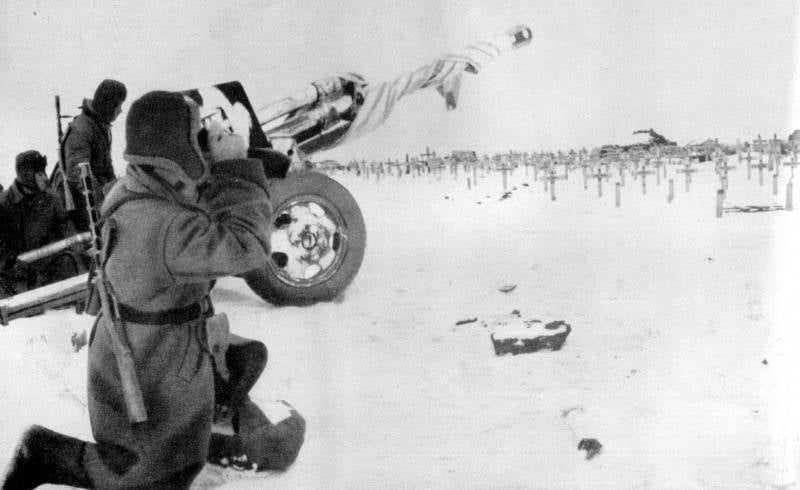
Soviet gunners, stationed at the German military cemetery, firing at German positions in Stalingrad from 76-mm divisional gun model 1942, ZiS-3
The Stavka directive noted: “... your main task in the first phase of the operation should be the cutting off and destruction of the western group of encircled enemy troops in the area of Kravtsov, Baburkin, Marinovka, Karpovka, so that the main attack of our troops from the Dmitrievka area, state farm No. 1, Baburkin turn south to the area of the Karpovskaya station, and send an auxiliary strike of 57 to the army from the Kravtsov and Sklyarov area to meet the main blow against it and close both blows near the Karpovskaya station. Along with this, the 66 army should be organized through Orlovka in the direction of the Krasny Oktyabr settlement, and to meet this blow, the 62 army should strike, so that both attacks would close and cut off the factory area from the main enemy group. ”
Based on the Bid instructions from December 28, the headquarters of the Don Front and then the army headquarters developed a plan for the first phase of the operation. His main task was formulated as follows: “The purpose of the operation: to cut off, encircle and destroy the western grouping of the surrounding enemy troops in the area: Kravtsov, Zapadnovka, and all. № 1, Dmitrievka, Marinovka ". 4 January 1943 This plan was finally approved. The main attack was laid on the 65 Army of General P.I.Batov, who was in the center of the shock group of the front. The troops of this army were given the task of attacking in the south-east direction on Novyy Rogachik and, in cooperation with other armies, to destroy the enemy in the area west of the r. Rossoshka.
Thus, the operation "Ring" envisaged the dismemberment of the surrounded Stalingrad grouping with a blow from west to east and, as a first stage, the destruction of enemy troops in the south-western projection of the encirclement. In the future, the advancing Soviet troops had to consistently dismember the encircled grouping and destroy it in parts.
Due to the late arrival of gain funds, the preparation of the operation did not end on January 6, as planned from the beginning, but four days later. The rate authorized the postponement of the start date of the operation to January 10 1943.
Soviet forces
The Don Front was significantly strengthened by artillery units, and from January 1, 1943, the 62nd, 64th and 57th armies of the Stalingrad Front were included in it (it was reorganized from the Southern), commanded by Generals V.I. Chuikov, M.S. Shumilov and F. I. Tolbukhin. Even earlier, the 21st Army of the Southwestern Front, commanded by General I.M. Chistyakov, was transferred to the Don Front. The 65th Army, which delivered the main blow, was significantly strengthened, which by the beginning of the operation consisted of eight rifle divisions, 27 artillery regiments of the RVGK, two divisions of rocket artillery, five anti-aircraft artillery regiments of the air defense, three separate artillery divisions of the air defense, six tank regiments, one tank brigade.
As part of the front to the beginning of the operation, there were 212 thousand people (the enemy had 250 thousand soldiers and officers), guns and mortars - 6860, tanks - 257, combat aircraft - 300. The Soviet troops had superiority in guns and mortars (more than one and a half times) and especially in aircraft (three times). The enemy possessed numerical superiority in humans (1,2: 1) and tanks (1,2: 1). True, the combat capability of the advancing Soviet troops was significantly higher than that of the blocked and weakened Paulus army.
In the direction of the main strike, a decisive predominance of forces and means over the enemy was created. For example, in the 65 offensive zone, the Soviet troops had: 62 people, thousand people, enemy - 31 300 (2: 1), guns and mortars - 2428 and 638 (4 and 1), respectively (127: 102), tanks - 1,2 and 1 ( 16: 100). A particularly large role in the operation was assigned to artillery. The most effective artillery fire control system was thought out. Part of the artillery gain was transferred to the rifle divisions, in the support groups of the infantry. The main forces of the front artillery were concentrated in the offensive zone of the army, which was solving the main task, by creating an army long-range group (ADD) and a group of artillery of destruction (AR). The actions of the advancing ground forces were supposed to support the 80 Air Force, which by then had 40 fighters, 80 bomber, XNUMX attack aircraft, and XNUMX night bombers.
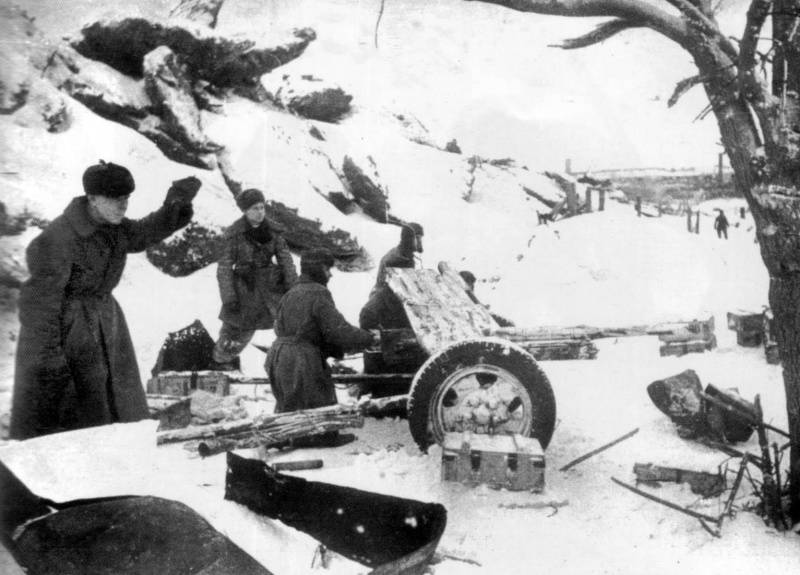
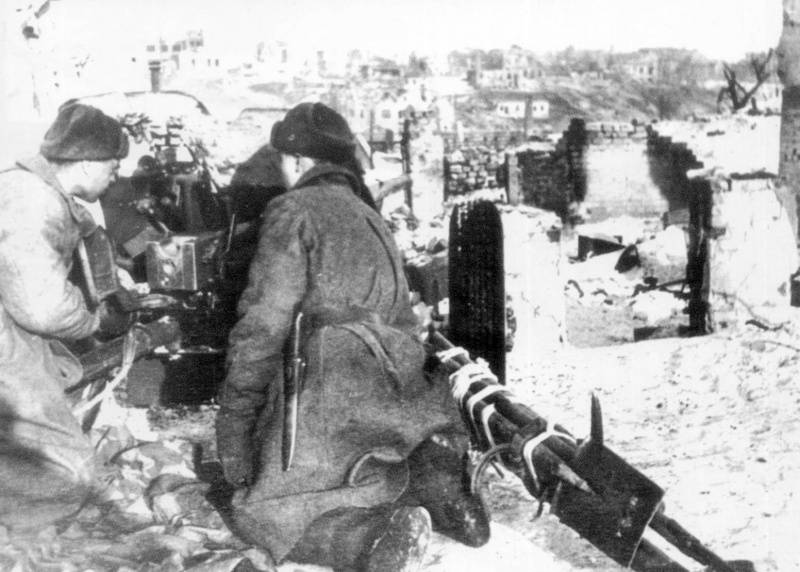
Soviet soldiers firing 45-mm anti-tank gun model 1937, 53-K on German positions in Stalingrad. January 1943
Germans
By the end of December 1942, the external front moved away from the grouping on 200 - 250 km surrounded by Stalingrad, passing along the line of Novaya Kalitva - Millerovo - Morozovsk - Zimovniki. The territory occupied by the Nazis, was 1400 square. km Enveloped in a dense ring of an environment of about 170 km in length (from north to south - 35 km, from west to east - 53 km), the enemy created a strong and deep defense inside it. The Germans used for this purpose and the former defensive lines of the Soviet troops. The terrain, with its small heights and numerous beams with steep steep shores, as well as a large number of settlements contributed to the organization of solid defense and made offensive operations more difficult.
The presence of equipped airfields in the areas of the Nursery, Basargino junction, Bol. Rossoshki, Gumrak, Art. Voroponovo and others allowed the Germans to take a significant number of aircraft. On average, from 50 tons (in November) to 105 tons of cargo (in December) was transported per day. From January 12 to February 2, this norm did not exceed 60 - 80 tons. On the most successful days, up to 150 tons of cargo were transferred. And in order to maintain the minimum combat effectiveness of the encircled troops, daily deliveries of 700 to 900 tons of cargo (ammunition, food, fuel, etc.) were required. This is a German task aviation I could not decide.
German aviation was not able to perform the task entrusted to it to supply the encircled army. The Soviet 17, 8 and 16 air armies, as well as aviation and anti-aircraft artillery of the country's air defense forces, disrupted the delivery of cargo to the "boiler" and destroyed the enemy's transport aircraft. Both the supply bases and the airfields located in the enclosed area were subjected to bombing and ground attack. To combat the enemy's aircraft, Soviet aviation used patrols, duty at the airfield and free hunting. In early December, organized by the Soviet troops, the system of combating the enemy's air transport was based on the division into areas of responsibility. The first zone included the territories from which the supply of the encircled grouping took place, units of the 17 and 8 of the air armies acted here. The second zone was located around the troops of Paulus over the territory controlled by the Red Army. It was created two belts of guidance stations, the zone itself was divided into 5 sectors, one fighter aviation division in each (air defense fighters and 8 and 16 divisions of the air armies). In the third zone was located anti-aircraft artillery, it also surrounded the blocked grouping. It was 15-30 km deep, and at the end of December 1942 had 235 small and medium-caliber guns in it and an 241 anti-aircraft gun. The area occupied by the surrounded Stalingrad group belonged to the fourth zone, there were units of the 8 and 16 air armies and a night regiment of the air defense division. In December, hundreds of enemy transport aircraft were shot down near Stalingrad.
In addition, the supply base of the German army was gradually removed to the west, which worsened the capabilities of German aviation. At first, the main bases for the supply of the blocked troops were Tatsinskaya, Morozovsk, Tormosin and Bogoyavlenskaya. But as the Soviet troops moved to the west, the Germans had to move the supply bases further and further from the troops of Paulus's army: to Zverevo, Shakhty, Kamensk-Shakhtinsky, Novocherkassk, Mechetinskaya and Salsk. At the last stage, airfields were used in Artyomovsk, Gorlovka, Makeyevka and Stalino. As a result, the distance from the enemy aviation bases to the landing sites of the 6 Army was initially 200 km, then increased to 300 and, finally, 450 km.
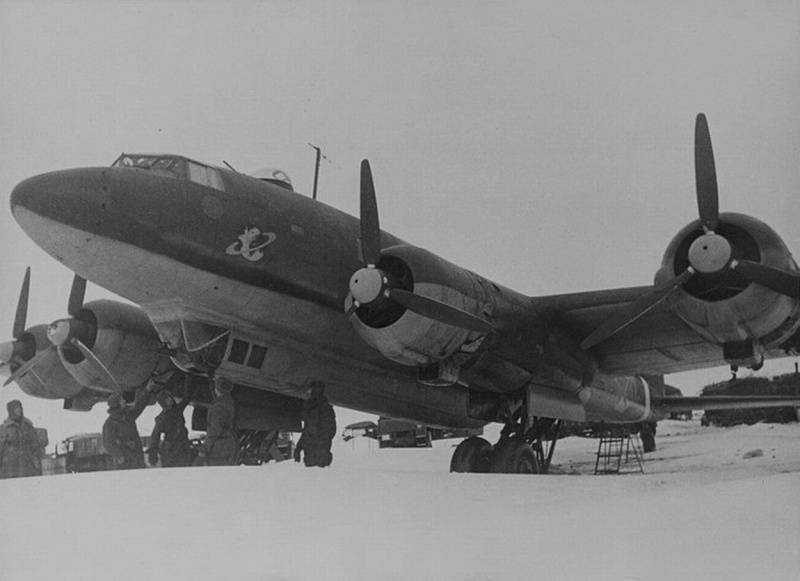
The German long-distance reconnaissance bomber Focke-Wulf Fw.200 "Condor" captured by Soviet troops at the airfield Nursery (Stalingrad region)
In the first period, the German soldiers believed that the matter was still fixable, that the external front of the encirclement would be broken in the near future. This faith gave them the strength to fight in the most difficult conditions. The officers inspired the soldiers that outside help was coming to Stalingrad. In the second week of December, it became known that large forces under the command of Field Marshal Manstein launched an operation to unblock an surrounded group (As the Germans tried to save the army of Paulus. Operation "Winter Thunderstorm"; "Winter Thunderstorm." H. 2; How to stop the breakthrough of the army group "Got"). The news of the attack of the army group "Got", notes K. Tippelskirkh, "caused a general rise." Recalling these days in the “boiler”, Joachim Wieder noted: “With lightning speed, the cry“ Manstein is coming! ”Spread like new password in all parts of the ring, and above all in our western section of the“ boiler ” where it was particularly tight ... Salvation seemed close. " However, these illusions disappeared when the Manstein-Goth attack failed, and the German troops began to retreat to Rostov.
The last hopes for help from outside, which gave the soldiers moral strength to hold on to the last, disappeared. Under the onslaught of the Soviet troops, the territory of the “cauldron” was gradually shrinking, which now almost all was swept by artillery. Aircraft attacked the nazis from the air. The 62 Army now led offensive battles of a local character. Her warriors were now advancing and knocking out the Nazis from their strongholds and resistance centers, conquering the building after the building, and the street after the street. The Germans realized that they were doomed.
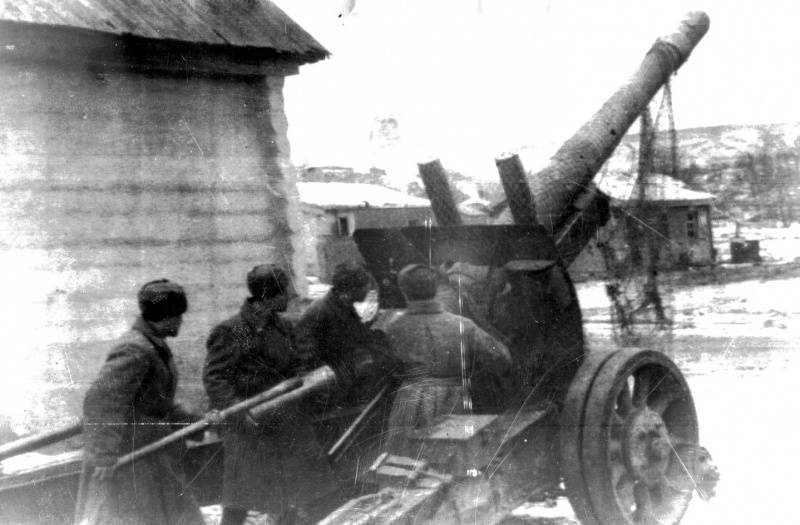
Soviet artillerymen, at the rate of sergeant Bardadymov, are firing at enemy subsidiaries and subordinates on the outskirts of Stalingrad from an 152-mm howitzer ML-20 howitzer 1937 of the year
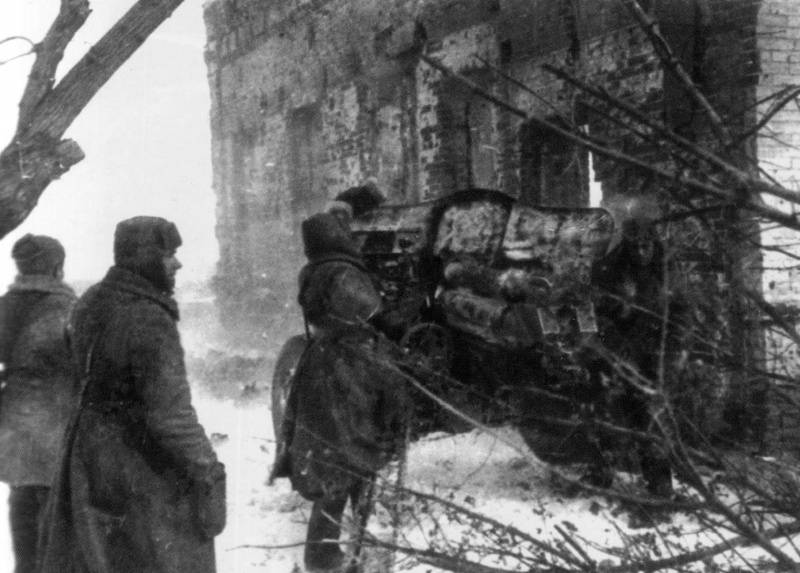
Soviet gunners firing 76-mm divisional gun model 1939 of the year (SPM) on the German positions on the ruins of Stalingrad
The supply has steadily deteriorated. Had to save ammunition, food, fuel, medicines, etc. The food ration fell to 100 g of bread. Horsemeat was a luxury. Soldiers hunted dogs, cats and birds. This is how Colonel Dingler describes the disasters of the 6 Army: ““ Every night, sitting in dugouts, we listened to the roar of the engines and tried to guess how many German aircraft would fly this time and what they would deliver to us. Food was very difficult from the very beginning, but none of us imagined that soon we would constantly suffer from hunger. We lacked everything: there was not enough bread, shells, and most importantly - fuel. While it was fuel, we could not freeze, and our supply, albeit on a limited scale, was ensured. Firewood had to be delivered from Stalingrad by car, but since we lacked gasoline, it was very rare to go to the city for fuel and it was very cold in our dugouts. Before Christmas 1942 of the year (December 26), troops were given 100 grams of bread per person per day, and after Christmas this ration was reduced to 50 grams. Later, these 50 grams of bread received only those units that were directly engaged in hostilities; in headquarters, starting from the regiment and above, they did not give out bread at all. The rest fed on liquid soup, which they tried to make stronger, digesting horse bones. ”
The surrounded soldiers suffered from frosts (the temperature at the end of December and in January reached minus 20 – 30 degrees), without receiving winter uniforms. During the Soviet counteroffensive (Operation Uranus), army rear bases in Morozovskaya, Tatsinskaya and further to the west remained outside the “boiler”. There were stored tens of thousands of sets of winter uniforms - overcoats with fur, felt boots, wool socks, balaclavas and headphones. As a result, the overwhelming majority of German troops met winter, almost without having appropriate clothing.
As a result, the German army and without active hostilities lost about 1500 people per day during local clashes, strikes of Soviet aviation and artillery, as well as from hunger, frost and disease. The German historian F. Mellenthin in the book “Tank battles of 1939 – 1945” describes the death of the 6 Army: “The Sixth Army was doomed, and now nothing could save Paulus. Even if by some miracle Hitler managed to get consent to attempt to break out of encirclement, the exhausted and half-starved troops would not be able to break the Russian ring, they would not have the means to retreat to Rostov along the ice-covered steppe. The army would have perished during the march, like Napoleon’s soldiers during the retreat from Moscow to the Berezina River. ”
At the same time, the surrounded German group still maintained its combat capability and had the following composition before the start of the operation: 250 personnel thousand people (during December the Germans lost about 80 thousand people), 4130 guns and mortars, 300 tanks and 100 aircraft. However, the moral, psychological and physical condition of the surrounded troops was extremely difficult. Despite the hopelessness of the situation, telegrams from Berlin “Stand up to the end!” Continued to arrive from Berlin. And the once elite German 6 army was ready to hold on, relying on a solid network of strong points and resistance nodes.
“The fact that we are not leaving here should be a fanatical principle,” said Hitler. In order No. 2 from 28 December 1942, when it was already clear that the Wehrmacht had no forces to release the surrounded grouping in Stalingrad, he stated: “... As before, my intention remains to keep the 6 army in its fortress ( in Stalingrad) and create the prerequisites for her release. ” On New Year's Day, the Führer's personal radiogram was received in the name of the commander of the surrounded group. She reaffirmed that Hitler "will not leave to the mercy of the heroic fighters on the Volga and that Germany has the means for the de-blockade of the 6 Army".
6 th army remained to die, until the last handing over the Soviet troops, or to capitulate. The High Command of the Wehrmacht, without thinking, decided to continue the resistance until the last soldier. By this it has doomed tens of thousands of soldiers to death. Such a decision was determined by the motives of both prestige and military strategy. Containment of the Soviet forces in the Stalingrad area, the German high command sought to prevent the collapse of the entire southern wing of the Eastern Front. However, after the failure of Manstein’s offensive and then the loss (in January) of the airfield in the Pitomnik area, the resistance of the surrounded Stalingrad group lost its former military strategic importance. But nevertheless it was continued.
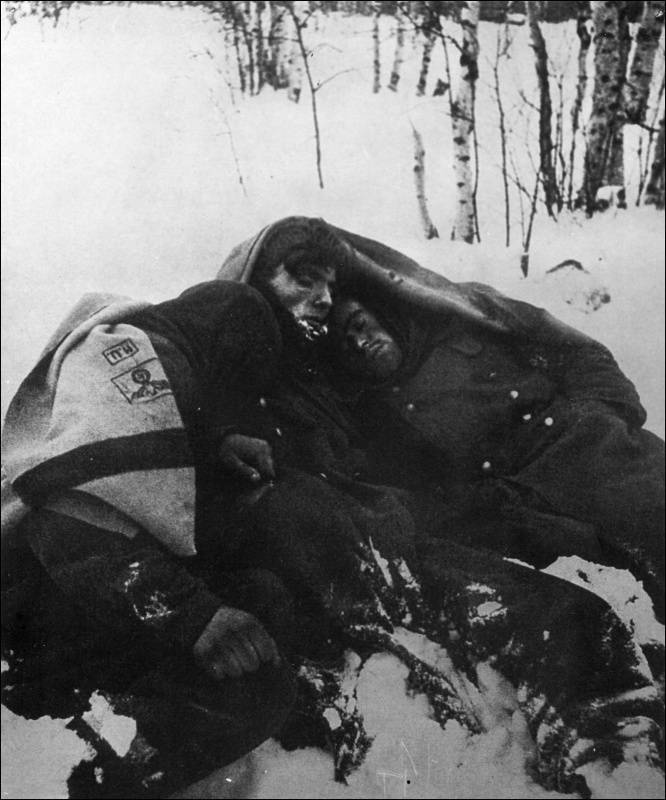
Frozen Germans near Stalingrad
Ultimatum
On January 8, the command of the Don Front presented an ultimatum to the command of the encircled grouping demanding that it stop its senseless resistance and accept the terms of surrender. The ultimatum, signed by N. N. Voronov, representative of the Supreme Command Headquarters, and K. K. Rokossovsky, commander of the Don Front, was broadcast by F. Paulus headquarters and delivered by parliamentarians. As volunteers who volunteered to go to the camp of the enemy for the delivery of an ultimatum, the following were approved by the envoy: Major A. Smyslov, worker of the headquarters of the Don Front, interpreter, captain N. N. Dyatlenko.
The ultimatum noted: “All hopes for the salvation of your troops by the offensive of the German troops from the south and southwest did not materialize. The German troops hurrying to your aid are defeated by the Red Army, and the remnants of these troops retreat to Rostov. The German transport aviation, which transports your food, ammunition and fuel standards to you, due to the successful rapid advance of the Red Army, is often forced to change airfields and fly to locations surrounded from afar. In addition, German transport aviation suffers huge losses in aircraft and crews from Russian aviation. Her help to the surrounded troops becomes unreal.
The position of your surrounded troops is difficult. They experience hunger, disease, and cold. The harsh Russian winter begins; severe frosts, cold winds and blizzards are still ahead, and your soldiers are not provided with winter clothing and are in difficult unsanitary conditions. You, as commander, and all the officers of the encircled troops are well aware that you have no real opportunity to break through the ring of encirclement. Your situation is hopeless, and further resistance makes no sense. ”
The Germans were asked to stop the resistance and transfer to the Soviet disposal all the personnel, weapons, all military equipment and military equipment in good condition. The enemy was guaranteed "life and security, and after the war ended, return to Germany or to any country where prisoners of war would express their desire." All personnel were offered to keep their military uniforms, insignia and orders, personal belongings, values, and the highest officers and cold weapon. All who had surrendered were promised normal food, and the wounded, sick, and frostbite - medical care.
However, the commander of the German 6-th Army rejected the proposal of the Soviet command. On the same day, the commander of the 14 tank corps of General Huba returned to Stalingrad. He returned to the "pot" from Hitler's headquarters, where 28 December flew out to receive the award and where, on the instructions of Paulus, he reported to the Führer on the situation of the surrounded army. Hube brought Hitler's order to continue resistance until the new deblocking offensive of the Wehrmacht, which was promised to begin in the second half of February. Paulus summoned corps commanders who already knew the text of the Soviet ultimatum. The commander also introduced them to General Hube’s report. They all spoke out against surrender. Then came the response of the ground command of the ground forces (OKH). He read: “Surrender is excluded. Every extra day that the army keeps on helps the whole front and draws Russian divisions from it. ”
F. Paulus after the war, in September, 1945, explained his behavior at that moment: “I was a soldier and believed then that I served my people with obedience. As for the responsibility of the officers subordinate to me, from a tactical point of view, they, in carrying out my orders, were in the same forced position as I myself was in the framework of the overall operational situation and the orders given to me. ”
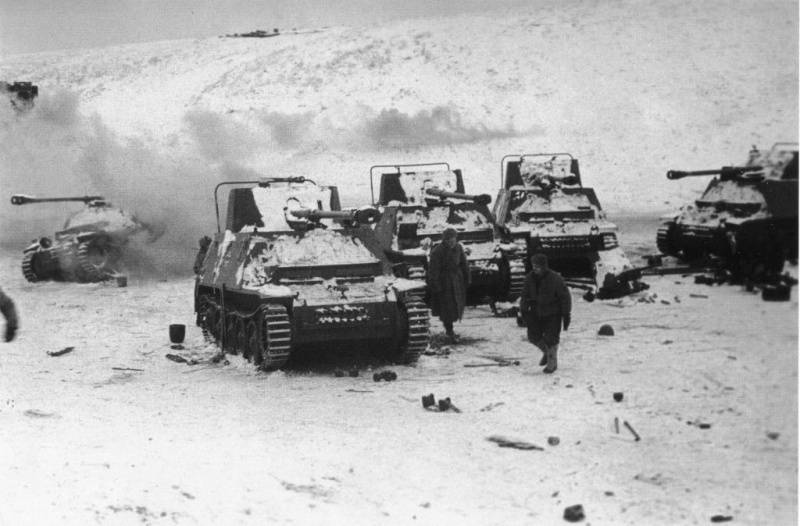
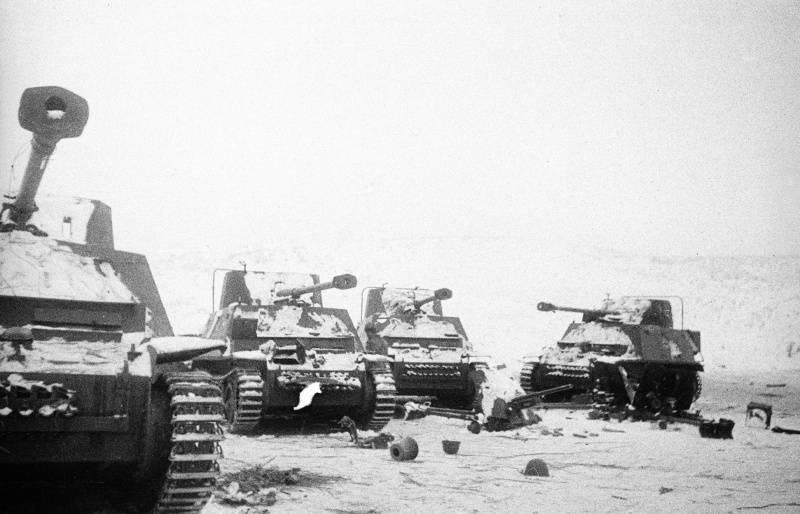
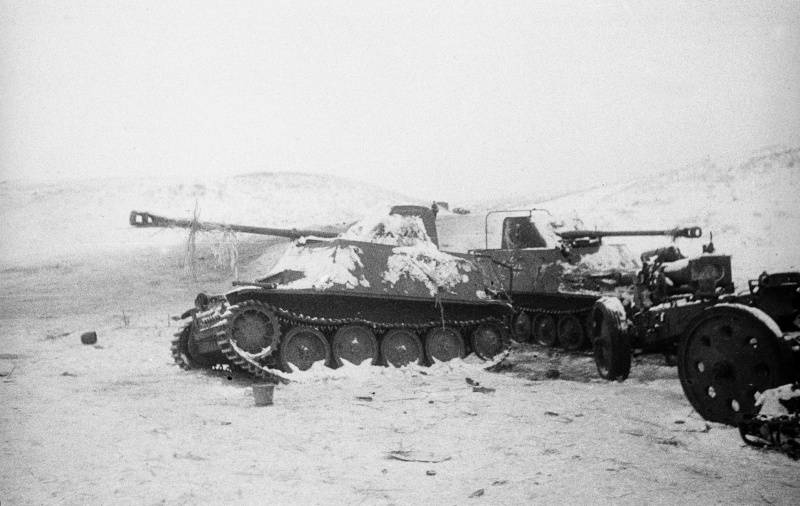
Abandoned German self-propelled guns, captured by Soviet troops in the Stalingrad boiler. This is a Marder II ACS with a 76,2-mm gun. Photo source: http://waralbum.ru/
To be continued ...
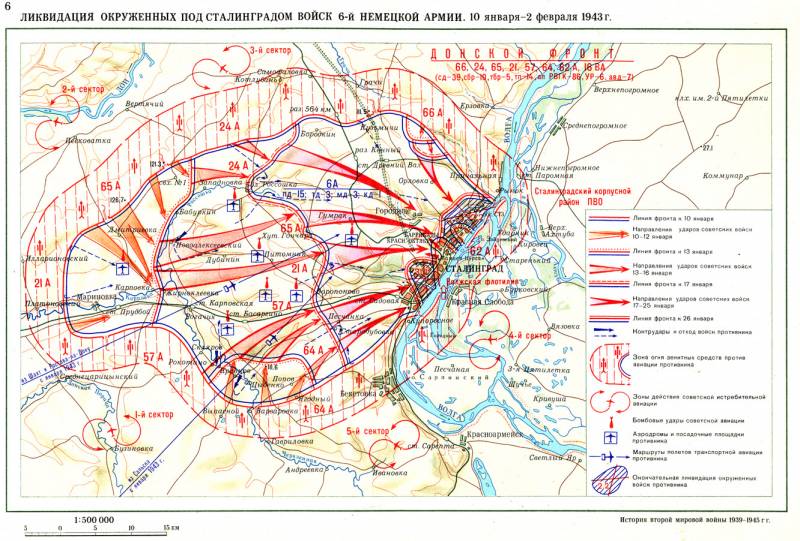
Information